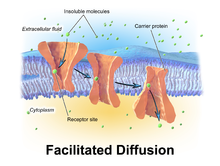Facilitated diffusion

Facilitated diffusion refers to the transport of molecules through a biomembrane via channel proteins or transport proteins .
properties
The diffusion of polar or ionic molecules through the double lipid layer of a biomembrane is comparatively low without channel proteins or transport proteins. In contrast to diffusion, with facilitated diffusion, due to the limited number of these proteins per biomembrane, a saturation effect of the diffusion rate sets in with the increase in the concentration of the molecule. In the case of diffusion, on the other hand, the diffusion rate increases proportionally to the difference in concentration between the two sides of the biomembrane, albeit to a lesser extent. Furthermore, the facilitated diffusion due to the protein folding of the proteins involved is temperature-dependent, because at a low temperature the rate decreases sharply.
literature
- Bruce Alberts: Textbook of Molecular Cell Biology. Wiley-VCH, April 2005, ISBN 3-527-31160-2 .
Individual evidence
- ↑ Morton Friedman: Principles and models of biological transport. Jumper. ISBN 978-0387-79239-2 .
